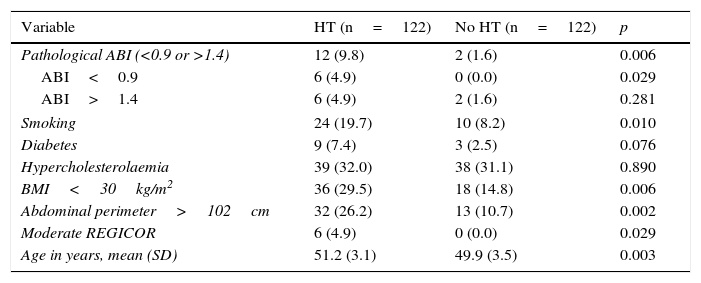The ankle-brachial index allows for the detection of subclinical cardiovascular disease and risk, by diagnosing peripheral arterial disease and arterial calcification. Asymptomatic hypertensive men, between 45 and 55 years and with the suspicion of low risk, could be an important population group to benefit from this technique. The aim of the study was to compare the frequency of abnormal ankle-brachial index (subclinical peripheral arterial disease and arterial calcification) between asymptomatic hypertensive and non-hypertensive men, of the same age and suspicion of low risk.
Patients and methodsTwo hundred and forty-four asymptomatic men (122 hypertensive and 122 non-hypertensive), between 45 and 55 years and an REGICOR index <10, were voluntarily recruited using consecutive sampling. Complete anamnesis, physical examination, laboratory tests and ankle-brachial index determination were carried out on all patients.
ResultsWe detected abnormal ankle-brachial index values in 9.8% (12 cases) of the hypertensive subjects and in 1.6% (2 cases) of non-hypertensive subjects (p=.006). In the multivariate analysis, hypertension was significantly associated with an abnormal ankle-brachial index (p<.026) (odds ratio [OR] 5.9, 95% confidence interval [95% CI] 1.2–28.3), smoking (p=.018) (OR 2.7; 95% CI 1.2–6.2) and abdominal obesity (p=.005) (OR 2.8; 95% CI 1.3–5.9).
ConclusionsThe population group analysed in this study might be considered as an overriding segment for detecting subclinical cardiovascular disease and risk with the ankle-brachial index. Further studies are needed to establish the prevalence of abnormal ankle-brachial index in this population in order to assess its efficiency.
El índice tobillo-brazo permite detectar riesgo y enfermedad cardiovascular subclínica, diagnosticando enfermedad arterial periférica y calcificación arterial. Los varones hipertensos asintomáticos, con edades entre 45-55 años y baja sospecha de riesgo, podrían ser un importante grupo poblacional para beneficiarse de esta técnica. El objetivo del presente estudio ha sido comparar la frecuencia de índice tobillo-brazo patológico (enfermedad arterial periférica subclínica y calcificación arterial) entre varones hipertensos y no hipertensos en esta franja de edad, asintomáticos y con baja sospecha de riesgo.
Pacientes y métodoUn total de 244 varones asintomáticos (122 hipertensos y 122 no hipertensos) entre 45-55 años de edad y REGICOR<10 fueron seleccionados voluntariamente mediante muestreo consecutivo. Se practicó anamnesis, exploración física, analítica e índice tobillo-brazo a todos los pacientes.
ResultadosSe detectó índice tobillo-brazo patológico en el 9,8% (12 pacientes) de los hipertensos y en el 1,6% (2 pacientes) de los no hipertensos (p=0,006). En el análisis multivariante la hipertensión arterial se asoció significativamente (p=0,026) con índice tobillo-brazo patológico (odds ratio [OR] 5,9; intervalo de confianza del 95% [IC 95%] 1,2-28,3), tabaquismo (p=0,018) (OR 2,7; IC 95% 1,2-6,2) y obesidad abdominal (p=0,005) (OR 2,8; IC 95% 1,3-5,9).
ConclusionesEl grupo poblacional propuesto parece constituir un segmento primordial para detectar riesgo y enfermedad cardiovascular subclínica mediante el índice tobillo-brazo en sujetos con baja sospecha. Será necesario, sin embargo, realizar estudios de prevalencia de índice tobillo-brazo patológico en dicha población para valorar su eficiencia.








